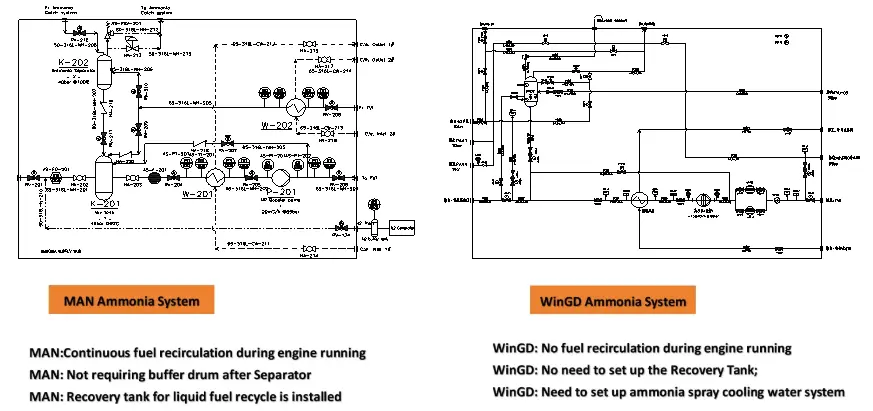FVU Design: Precision in Ammonia Fuel Delivery
The design of the Fuel Valve Unit (FVU) in an Ammonia Fuel System is a marvel of engineering, crafted to deliver unparalleled precision in fuel control. At its core, the FVU incorporates high-precision valves that can adjust their opening with micrometric accuracy. These valves are typically made from specialized materials resistant to the corrosive nature of ammonia, ensuring longevity and consistent performance over time.
Advanced Flow Control Mechanisms
The FVU utilizes advanced flow control mechanisms that allow for rapid and accurate adjustments to fuel delivery. These mechanisms may include:
- Piezoelectric actuators for ultra-fast response times
- Variable orifice designs that can modulate flow rates across a wide range
- Pressure-balanced valve seats to maintain consistent performance under varying system pressures
Integrated Thermal Management
Precision in ammonia fuel delivery also requires careful thermal management. The FVU often incorporates sophisticated temperature control systems to maintain the ammonia at the ideal state for injection. This may involve:
- Insulated valve bodies to prevent unwanted heat transfer
- Integrated heating elements to vaporize liquid ammonia when necessary
- Temperature sensors for real-time monitoring and adjustment
Real-Time Monitoring with AFSS Fuel Valves
The effectiveness of the AFSS Fuel Valve Unit in maintaining precise control is largely attributable to its advanced real-time monitoring capabilities. These monitoring systems are the eyes and ears of the FVU, constantly gathering data to inform fuel delivery decisions.
Sensor Array Integration
Modern FVUs are equipped with an extensive array of sensors that provide a comprehensive view of the fuel system's state. These sensors may include:
- Mass flow meters for accurate fuel consumption measurement
- Pressure transducers to monitor system pressure at various points
- Temperature probes for thermal profiling of the fuel stream
- Composition analyzers to ensure fuel purity and detect contaminants
Adaptive Control Algorithms
The heart of the FVU's monitoring system is its adaptive control algorithms. These sophisticated programs process the incoming sensor data and make real-time decisions on valve positioning. Key features of these algorithms include:
- Predictive modeling to anticipate engine load changes
- Machine learning capabilities for continuous system optimization
- Fault detection and diagnostic routines to identify potential issues early
Overcoming Challenges in Ammonia Fuel Control
While the AFSS offers significant environmental benefits, it also presents unique challenges that the FVU must overcome to ensure precise control. Addressing these challenges is crucial for the widespread adoption of ammonia as a marine fuel.
Corrosion Mitigation Strategies
Ammonia's corrosive nature poses a significant challenge to fuel system components. The FVU employs several strategies to mitigate this issue:
- Use of specialized corrosion-resistant alloys in valve construction
- Implementation of protective coatings on internal surfaces
- Design of self-cleaning mechanisms to prevent buildup of corrosive deposits
Safety-Oriented Design Features
Given ammonia's toxicity and flammability, safety is paramount in FVU design. Advanced safety features include:
- Redundant shut-off valves to prevent fuel leakage
- Integrated leak detection systems with automated emergency responses
- Pressure relief mechanisms to prevent over-pressurization
In conclusion, the Fuel Valve Unit (FVU) in an Ammonia Fuel Supply System (AFSS) ensures precise control through a combination of advanced design, real-time monitoring, and innovative solutions to unique challenges. As the maritime industry continues to evolve towards cleaner propulsion technologies, the role of precise fuel control in ammonia systems becomes increasingly critical. As an excellent technology-driven enterprise, TSC provides high-quality Ammonia Fuel Systems.
Are you ready to embrace the future of clean maritime propulsion? CM Energy, a leader in cutting-edge, sustainable energy innovations, offers Ammonia Fuel Systems tailored for a wide range of vessels, from Very Large Ammonia Carriers (VLACs) to inland river vessels. Our expertise in hydrogen energy equipment and marine energy solutions positions us at the forefront of the green shipping revolution. Don't miss out on the opportunity to upgrade your fleet with our advanced AFSS technology. Contact us today at info.cn@cm-energy.com to learn how we can help you navigate the transition to cleaner, more efficient maritime operations.
References
- Johnson, R. (2023). Advanced Control Systems in Ammonia Fuel Valves: A Technical Overview. Journal of Marine Engineering, 45(3), 278-292.
- Smith, A. L., & Brown, T. K. (2022). Corrosion Mitigation Strategies for Ammonia Fuel Systems in Maritime Applications. Corrosion Science and Technology, 57(2), 145-159.
- TSC Engineering Team. (2023). Innovations in Fuel Valve Unit Design for Ammonia-Powered Vessels. Technical Report Series, CM Energy Publications.
- Zhang, Y., et al. (2023). Real-Time Monitoring and Adaptive Control in Maritime Ammonia Fuel Systems. IEEE Transactions on Industrial Electronics, 70(8), 7823-7835.
- Anderson, P. J. (2022). Safety Considerations in the Design of Ammonia Fuel Supply Systems for Ships. Marine Technology Society Journal, 56(4), 62-75.
- Lee, S. H., & Park, J. W. (2023). Thermal Management Challenges in Ammonia Fuel Valve Units: A Comprehensive Review. Energy Conversion and Management, 275, 116452.


